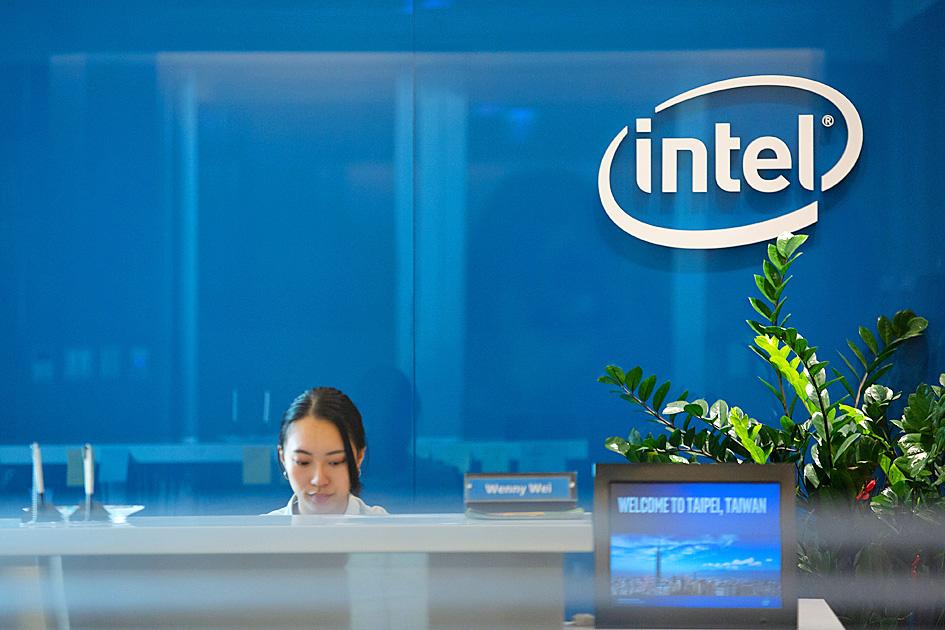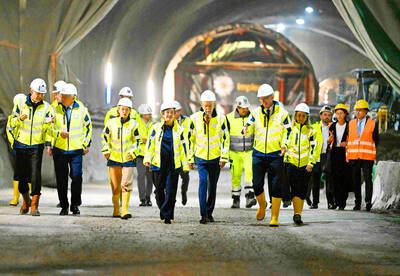Intel Corp has talked with Taiwan Semiconductor Manufacturing Co (TSMC, 台積電) and Samsung Electronics Co about the Asian companies making some of its best chips, but the Silicon Valley pioneer is still holding out hope for last-minute improvements in its own production capabilities.
After successive delays in its chip fabrication processes, Santa Clara, California-based Intel has yet to make a decision less than two weeks ahead of a scheduled announcement of its plans, people familiar with the deliberations said.
Any components that Intel might source from Taiwan would not come to market until 2023 at the earliest and would be based on established manufacturing processes already in use by other TSMC customers, said the people, asking not to be identified because the plans are private.

Photo: Ashley Pon, Bloomberg
Talks with Samsung, whose foundry capabilities trail TSMC’s, are at a more preliminary stage, the people said.
TSMC and Samsung representatives declined to comment, while an Intel spokesperson referred to previous comments by CEO Bob Swan, who has promised investors he would set out his plans for outsourcing and putting Intel’s production technology back on track when the company reports earnings on Thursday next week.
TSMC, the largest maker of semiconductors for other companies, is preparing to offer Intel chips manufactured using a 4-nanometer process, with initial testing using an older 5-nanometer process, the people said.
The company has said it would make test production of 4-nanometer chips available in the fourth quarter of this year and volume shipments the following year.
TSMC expects to have a new facility in Hsinchu County’s Baoshan Township (寶山) operational by the end of this year, which can be converted to production for Intel if required, one of the people said.
TSMC executives previously said the Baoshan unit would house a research center with 8,000 engineers.
Intel’s strategic shifts are happening at a time of booming demand, as well as technological change in the chip industry.
The traditional method of improving performance by shrinking and cramming more transistors into each package is being supplanted by more sophisticated techniques that include stacking processor and memory components into single chips and the introduction of more tailored designs for tasks like artificial intelligence.
Separately, United Microelectronics Corp (UMC, 聯電) on Saturday had power-supply disruptions at two plants in Hsinchu that temporarily affected production, UMC chief financial officer Liu Chi-tung (劉啟東) said.
“The company will discuss with customers, and try its best to make up for lost production,” Liu said by telephone. “No major financial impact is expected.”
The overall impact of the incident was “quite minor,” Liu said.
Power was being gradually restored, he said.

CHIP RACE: Three years of overbroad export controls drove foreign competitors to pursue their own AI chips, and ‘cost US taxpayers billions of dollars,’ Nvidia said China has figured out the US strategy for allowing it to buy Nvidia Corp’s H200s and is rejecting the artificial intelligence (AI) chip in favor of domestically developed semiconductors, White House AI adviser David Sacks said, citing news reports. US President Donald Trump on Monday said that he would allow shipments of Nvidia’s H200 chips to China, part of an administration effort backed by Sacks to challenge Chinese tech champions such as Huawei Technologies Co (華為) by bringing US competition to their home market. On Friday, Sacks signaled that he was uncertain about whether that approach would work. “They’re rejecting our chips,” Sacks

It is challenging to build infrastructure in much of Europe. Constrained budgets and polarized politics tend to undermine long-term projects, forcing officials to react to emergencies rather than plan for the future. Not in Austria. Today, the country is to officially open its Koralmbahn tunnel, the 5.9 billion euro (US$6.9 billion) centerpiece of a groundbreaking new railway that will eventually run from Poland’s Baltic coast to the Adriatic Sea, transforming travel within Austria and positioning the Alpine nation at the forefront of logistics in Europe. “It is Austria’s biggest socio-economic experiment in over a century,” said Eric Kirschner, an economist at Graz-based Joanneum

BUBBLE? Only a handful of companies are seeing rapid revenue growth and higher valuations, and it is not enough to call the AI trend a transformation, an analyst said Artificial intelligence (AI) is entering a more challenging phase next year as companies move beyond experimentation and begin demanding clear financial returns from a technology that has delivered big gains to only a small group of early adopters, PricewaterhouseCoopers (PwC) Taiwan said yesterday. Most organizations have been able to justify AI investments through cost recovery or modest efficiency gains, but few have achieved meaningful revenue growth or long-term competitive advantage, the consultancy said in its 2026 AI Business Predictions report. This growing performance gap is forcing executives to reconsider how AI is deployed across their organizations, it said. “Many companies

France is developing domestic production of electric vehicle (EV) batteries with an eye on industrial independence, but Asian experts are proving key in launching operations. In the Verkor factory outside the northern city of Dunkirk, which was inaugurated on Thursday, foreign specialists, notably from South Korea and Malaysia, are training the local staff. Verkor is the third battery gigafactory to open in northern France in a region that has become known as “Battery Valley.” At the Automotive Energy Supply Corp (AESC) factory near the city of Douai, where production has been under way for several months, Chinese engineers and technicians supervise French recruits. “They